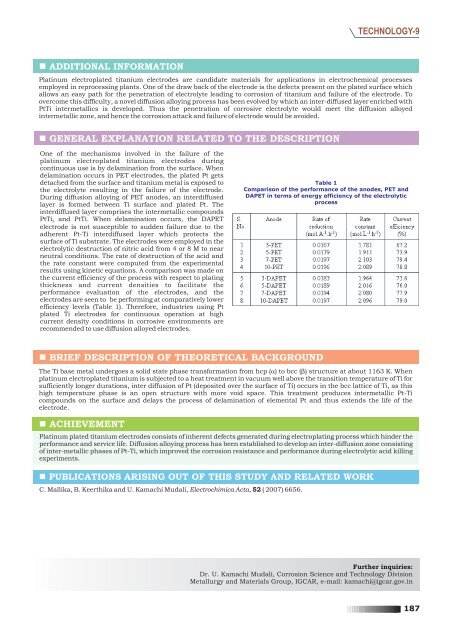Diffusion Alloyed Platinum Electroplated Titanium Electrodes for ...
Diffusion Alloyed Platinum Electroplated Titanium Electrodes for ...
Diffusion Alloyed Platinum Electroplated Titanium Electrodes for ...
You also want an ePaper? Increase the reach of your titles
YUMPU automatically turns print PDFs into web optimized ePapers that Google loves.
TECHNOLOGY-9<br />
ADDITIONAL INFORMATION<br />
<strong>Platinum</strong> electroplated titanium electrodes are candidate materials <strong>for</strong> applications in electrochemical processes<br />
employed in reprocessing plants. One of the draw back of the electrode is the defects present on the plated surface which<br />
allows an easy path <strong>for</strong> the penetration of electrolyte leading to corrosion of titanium and failure of the electrode. To<br />
overcome this difficulty, a novel diffusion alloying process has been evolved by which an inter-diffused layer enriched with<br />
PtTi intermetallics is developed. Thus the penetration of corrosive electrolyte would meet the diffusion alloyed<br />
intermetallic zone, and hence the corrosion attack and failure of electrode would be avoided.<br />
GENERAL EXPLANATION RELATED TO THE DESCRIPTION<br />
One of the mechanisms involved in the failure of the<br />
platinum electroplated titanium electrodes during<br />
continuous use is by delamination from the surface. When<br />
delamination occurs in PET electrodes, the plated Pt gets<br />
detached from the surface and titanium metal is exposed to<br />
the electrolyte resulting in the failure of the electrode.<br />
During diffusion alloying of PET anodes, an interdiffused<br />
layer is <strong>for</strong>med between Ti surface and plated Pt. The<br />
interdiffused layer comprises the intermetallic compounds<br />
PtTi3<br />
and PtTi. When delamination occurs, the DAPET<br />
electrode is not susceptible to sudden failure due to the<br />
adherent Pt-Ti interdiffused layer which protects the<br />
surface of Ti substrate. The electrodes were employed in the<br />
electrolytic destruction of nitric acid from 4 or 8 M to near<br />
neutral conditions. The rate of destruction of the acid and<br />
the rate constant were computed from the experimental<br />
results using kinetic equations. A comparison was made on<br />
the current efficiency of the process with respect to plating<br />
thickness and current densities to facilitate the<br />
per<strong>for</strong>mance evaluation of the electrodes, and the<br />
electrodes are seen to be per<strong>for</strong>ming at comparatively lower<br />
efficiency levels (Table 1). There<strong>for</strong>e, industries using Pt<br />
plated Ti electrodes <strong>for</strong> continuous operation at high<br />
current density conditions in corrosive environments are<br />
recommended to use diffusion alloyed electrodes.<br />
Table 1<br />
Comparison of the per<strong>for</strong>mance of the anodes, PET and<br />
DAPET in terms of energy efficiency of the electrolytic<br />
process<br />
BRIEF DESCRIPTION OF THEORETICAL BACKGROUND<br />
The Ti base metal undergoes a solid state phase trans<strong>for</strong>mation from hcp ( ) to bcc (β) structure at about 1163 K. When<br />
platinum electroplated titanium is subjected to a heat treatment in vacuum well above the transition temperature of Ti <strong>for</strong><br />
sufficiently longer durations, inter diffusion of Pt (deposited over the surface of Ti) occurs in the bcc lattice of Ti, as this<br />
high temperature phase is an open structure with more void space. This treatment produces intermetallic Pt-Ti<br />
compounds on the surface and delays the process of delamination of elemental Pt and thus extends the life of the<br />
electrode.<br />
ACHIEVEMENT<br />
<strong>Platinum</strong> plated titanium electrodes consists of inherent defects generated during electroplating process which hinder the<br />
per<strong>for</strong>mance and service life. <strong>Diffusion</strong> alloying process has been established to develop an inter-diffusion zone consisting<br />
of inter-metallic phases of Pt-Ti, which improved the corrosion resistance and per<strong>for</strong>mance during electrolytic acid killing<br />
experiments.<br />
PUBLICATIONS ARISING OUT OF THIS STUDY AND RELATED WORK<br />
C. Mallika, B. Keerthika and U. Kamachi Mudali, Electrochimica Acta, 52 ( 2007) 6656.<br />
Further inquiries:<br />
Dr. U. Kamachi Mudali, Corrosion Science and Technology Division<br />
Metallurgy and Materials Group, IGCAR, e-mail: kamachi@igcar.gov.in<br />
187
















